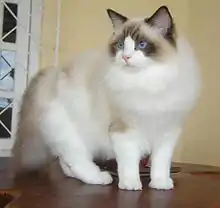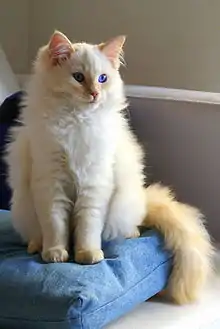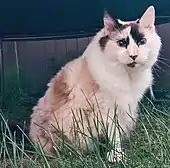Ragdoll
The Ragdoll is a breed of cat with a distinct colorpoint coat and blue eyes. Its morphology is large and weighty, and it has a semi-long and silky soft coat. American breeder Ann Baker developed Ragdolls in the 1960s. They are best known for their docile, placid temperament and affectionate nature. The name 'Ragdoll' is derived from the tendency of individuals from the original breeding stock to go limp and relaxed when picked up.[1] The breed is particularly popular in both the United Kingdom and the United States.
| Ragdoll | |
|---|---|
 Ragdoll cat | |
| Origin | California, United States |
| Breed standards | |
| CFA | standard |
| TICA | standard |
| Domestic cat (Felis catus) | |
Ragdolls are often known as "dog-like cats" or "puppy-like cats", due to their tendency to follow people around, their receptiveness to handling, and their relative lack of aggression towards other pets.[2]
Ragdolls are distinguishable by their pointed coloration (where the body is lighter than the face, ears, legs, and tail), large round blue eyes, soft, thick coats, thick limbs, long tails, and soft bodies. Their color rings are commonly tricolor or bicolor.[3]
History

The breed was developed in Riverside, California, by breeder Ann Baker. A regular, non-pedigreed, white domestic longhaired cat named Josephine produced several litters of typical cats.[4] Josephine was not of any particular breed, nor were the males who sired the original litters. Ann Baker herself said that the original cats of the Ragdoll breed were "alley cats".[5] Josephine later produced kittens with a docile, placid temperament, affectionate nature, and a tendency to go limp and relaxed when picked up.[6]
Out of those early litters came Blackie, an all-black male, and Daddy Warbucks, a seal point with white feet. Daddy Warbucks sired the founding bi-color female Fugianna, and Blackie sired Buckwheat, a dark brown/black Burmese-like female. Both Fugianna and Buckwheat were daughters of Josephine. All Ragdolls are descended from Baker's cats through matings of Daddy Warbucks to Fugianna and Buckwheat.[7][8]
Baker, in an unusual move, spurned traditional cat breeding associations. She trademarked the name Ragdoll, set up her own registry – the International Ragdoll Cat Association (IRCA) – around 1971, and enforced stringent standards on anyone who wanted to breed or sell cats under that name.[6] The Ragdolls were also not allowed to be registered by other breed associations.[9][10] The IRCA is still in existence today but is quite small, particularly since Baker's death in 1997.
In 1975, a group led by a husband-and-wife team, Denny and Laura Dayton, broke ranks with the IRCA to gain mainstream recognition for the Ragdoll. Beginning with a breeding pair of IRCA cats, this group eventually developed the Ragdoll standard currently accepted by major cat registries such as the CFA and the FIFe.[11] Around the time of the spread of the Ragdoll breed in America during the early 1960s, a breeding pair of Ragdolls was exported to the UK. Eight more cats followed this pair to fully establish the breed in the UK, where the Governing Council of the Cat Fancy recognizes it.[12]
Breed description
Temperament


The Ragdoll has been known to have a very floppy and calm nature, with claims that these characteristics have been passed down from the Persian and Birman breeds. Opinions vary as to whether this trait might be the result of genetic mutation or merely an instinctive reaction from being picked up as kittens by their mother.[13][14][15] The extreme docility of some individuals has led to the myth that Ragdolls are pain resistant. Some breeders in Britain have tried to breed away from the limpness owing to concerns that extreme docility 'might not be in the best interests of the cat'.[13][16]
Breed standard marketing and publicity material describe the Ragdoll as affectionate, intelligent, relaxed in temperament, gentle, and an easy-to-handle lap cat.[17][18] The animals are often known as 'puppy cats', 'dog-like cats', 'cat-dogs', etc., because of their placid nature and affectionate behavior, with the cats often following owners from room to room as well as seeking physical affection akin to certain dog breeds. Ragdolls can be trained to retrieve toys and enjoy doing so. They have a very playful nature that often lasts well into their senior years.[19] Unlike many other breeds, Ragdolls prefer staying low to the ground rather than the highest point in the household.[20]
Physical characteristics
The Ragdoll is one of the largest domesticated cat breeds. Fully-grown females weigh from 8 to 15 pounds (3.6 to 6.8 kg). Males are substantially larger, ranging from 12 to 20 pounds (5.4 to 9.1 kg) or more.[6] It can take up to four years for a Ragdoll to reach mature size.[8] They have a sturdy body, bulky frame, and proportionate legs. Their heads are broad with a flat top and wide space between the ears. They have long, muscular bodies with broad chests and short necks. Their tails are bushy and long in length, their paws are large, round, and tufted, and their coats are silky, dense, and medium to long length. Due to their coats tending to be long, they usually require brushing at least twice a week.[21] Adults develop knickerbockers on their hind legs and a ruff around their necks.
The breed is often known for its large round deep blue eyes,[22][23] though other cats may have that feature as well.[24] The genes for point coloration are also responsible for these distinctive blue eyes. More intense shades of blue are favored in cat shows.
.jpg.webp)
Although the breed has a plush coat, it consists mainly of long guard hairs, while the lack of a dense undercoat results, according to the Cat Fanciers' Association, in 'reduced shedding and matting'.[25] But there may be a noticeable increase of shedding in the spring.[26]
Ragdolls come in six distinct colors: seal, chocolate, red, and the corresponding 'dilutes': blue, lilac, and cream. There also are the lynx and tortoiseshell variations[27] in all colors and the three patterns. Ragdoll kittens are born white: they have good color at 8–10 weeks and full color and coat at 3–4 years.
Patterns
- Colorpoint – One color darkening at the extremities (nose, ears, tail, and paws),
- Mitted – Same as pointed but with white paws and abdomen. With or without a blaze (a white line or spot on the face), they must have a 'belly stripe' (white stripe that runs from the chin to the genitals) and a white chin. Mitted Ragdolls, which weren't allowed titling in CFA until the 2008–2009 show season, are often confused with Birmans. The easiest way to tell the difference is by size (the Ragdoll being larger) and chin color (Mitted Ragdolls have white chins,[28] while Birmans have colored chins), although breeders recognize the two by head shape and boning.[29]
- Bicolor – White legs, white inverted V on the face, white abdomen, and sometimes white patches on the back (excessive amounts of white, or 'high white', on a bicolor are known as the Van pattern, although this does not occur as often as the other patterns).
Variations

- Lynx – A variant of the colorpoint type having tabby markings.[30] This variation always comes with white ear lines, no matter the pattern.
- Tortoiseshell or "tortie" – A variant noted for mottled or parti-colored[31] markings in the above patterns. Despite the majoritively white coat, tortie points are not calico, as the calico gene is separate and not present in colorpoints.[32][33]
Health
One study, utilizing Swedish insurance data, showed that of the common cat breeds, the Ragdoll and Siamese have the lowest survival rate. They typically live from 12 to 15 years.[34]
Hypertrophic cardiomyopathy
Hypertrophic cardiomyopathy (HCM) is a common heart disease in all cats and is most commonly genetic in cause. The disease causes thickening of the cardiac wall, which makes the heart pump blood less efficiently. It can, in some instances, lead to sudden death. In Ragdolls that are homozygous positive for the disease (having two copies of the HCM gene), the condition can present early (as young as six months) and tends to be severe, with most cats dying by age 3. Heterozygous (one copy of HCM gene) cats tend to have later onset and slower progression of the disease, with less severe impact.[35][36]
A DNA test was developed in 2007 to identify the gene that causes HCM in Ragdolls. Breeding only from Ragdolls that are free from this gene (homozygous negative) will ensure that they will not develop the form of HCM associated with it.[35][36]
The allelic frequencies of the Ragdoll HCM mutation R820W were 0.17 in cats from Italy and 0.23 in cats from the US in 2013.[37] This reference states that the R820W prevalence is 30% in UK.[38] The HCM prevalence was found to be 2.9% (95% CI = 2.7–8.6%) in this study.[37]
References
- Becker, Marty; Spadafori, Gina (16 September 2006). Why Do Cats Always Land on Their Feet?: 101 of the Most Perplexing Questions ... – Marty Becker, Gina Spadafori – Google Books. ISBN 9780757305733. Retrieved 15 August 2014.
- Benjamin L. Hart; Lynette A. Hart (2013). Your Ideal Cat: Insights Into Breed and Gender Differences in Cat Behavior. Purdue University Press. pp. 99–101. ISBN 9781557536488.
- "Ragdoll". Petplan. Retrieved 14 May 2021.
- "Ragdoll – The Cat Fanciers' Association, Inc". cfa.org. Retrieved 20 November 2020.
- "History of the Ragdoll Cat Breed".
- Helgren, J. Anne (2006). "Ragdoll". Iams. Telemark Productions. Archived from the original on 13 November 2014.
- "Ragdoll History-The Beginning". Ragdoll Historical Society. Archived from the original on 18 February 2015. Retrieved 6 October 2014.
- Mattern, Joanne (2001). The Ragdoll Cat. Mankato, Minnesota: Capstone. pp. 5–16. ISBN 0736808973.
- "Ragdoll". Iams. Archived from the original on 28 September 2007.
- Robbins, Nancy (14 February 2012). Domestic Cats: Their History, Breeds and Other Facts. CreateSpace. p. 220. ISBN 9781470075385.
- "Raistrick Ragdolls". Raistrickragdfolls.co.uk. Archived from the original on 29 November 2014. Retrieved 15 November 2014.
- "Welcome to the Governing Council of the Cat Fancy". Archived from the original on 8 December 2012. Retrieved 14 December 2010.
- Understanding Cat Behavior: The Complete Feline Problem Solver Roger Tabor (2003). P 33.
- Do cats always land on their feet Gina Spadafori, Marty Becker
- "Why Do Ragdoll Cats Go Limp?". 17 January 2021. Retrieved 17 September 2021.
- The Cat: Its Behavior, Nutrition & Health Linda P. Case, Kerry Helms, Bruce Macallister (2003). P 31.
- Ragdoll Breed standard Governing Council of Cat Fancy
- Ragdoll Breed standard Cat Fanciers' Association
- Dina (2 February 2019). "Are Ragdoll Cats Playful?". purrcraze.com. Retrieved 24 June 2021.
- Braaksma, Hilary; Guthrie, Claudia. "Ragdoll". Daily Paws. Retrieved 1 December 2021.
- "Grooming Tips for a Ragdoll Cat". Petango. 28 March 2012. Retrieved May 31, 2022.
- "Ragdoll Cat Breed Information". www.purina.co.uk. Retrieved 24 June 2021.
- "Ragdoll Cats - A Complete Guide To The Ragdoll Cat Breed". The Happy Cat Site. 14 May 2019. Retrieved 24 June 2021.
- Braaksma, Hilary; Guthrie, Claudia (December 1, 2021). "Ragdoll". Daily Paws. Retrieved 1 December 2021.
- Breed Profile Archived 14 July 2009 at the Wayback Machine Cat Fanciers' Association
- "Ragdoll – The Cat Fanciers' Association, Inc". cfa.org. Retrieved 1 December 2021.
- "Ragdoll Introduction". Tica.org. Retrieved 15 December 2017.
- Mattern, Joanne. The Ragdoll Cat. capstone press. p. 19.
- "Birman vs Ragdoll". The Little Carnivore. Retrieved 24 January 2022.
- "Ragdoll International Patterns and Colors". Ragdollinternational.org. Retrieved 11 June 2012.
- "Ragdoll : POINT SCORE" (PDF). Cfa.org. Retrieved 15 December 2017.
- "Can a Ragdoll Cat be Calico?". ragdollcatsworld.com. Retrieved 11 August 2023.
- "Calico Ragdoll Cat - Can Ragdolls Have Calico Coloring?". thehappycatsite.com. Retrieved 11 August 2023.
- Egenvall, A.; Nødtvedt, A.; Häggström, J.; Ström Holst, B.; Möller, L.; Bonnett, B. N. (2009). "Mortality of Life-Insured Swedish Cats during 1999–2006: Age, Breed, Sex, and Diagnosis". Journal of Veterinary Internal Medicine. 23 (6): 1175–1183. doi:10.1111/j.1939-1676.2009.0396.x. PMC 7167180. PMID 19780926.
- "Minutes of Executive Council Meeting No: 28 (doc)". New Zealand Cat Fancy. 25 September 2011. Retrieved 8 February 2012.
- "Frequently Asked Questions about the HCM Genetic Mutation Predominantly Found in Ragdoll Cats". NC State College of Veterinary Medicine. Retrieved 8 February 2012.
- "Myosin-Binding Protein C DNA Variants in Domestic Cats (A31P, A74T, R820W) and Their Association with Hypertrophic Cardiomyopathy" (PDF). Vetogene.it. Retrieved 15 December 2017.
- "Hypertrophic cardiomyopathy (HCM) in cats". Fabcats.org. Retrieved 15 December 2017.